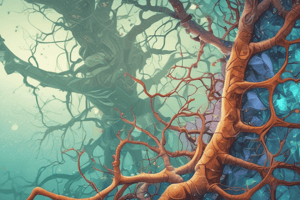Podcast
Questions and Answers
What is the main focus of the branch of biology known as ecology?
What is the main focus of the branch of biology known as ecology?
- Study of the structure and function of cells
- Study of the diversity of plant species
- Study of the interactions between organisms and their environment (correct)
- Study of the genetic material of an organism
What is the site of protein synthesis in a cell?
What is the site of protein synthesis in a cell?
- Mitochondria
- Lysosomes
- Ribosomes (correct)
- Nucleus
Which of the following is NOT one of the laws of inheritance in Mendelian genetics?
Which of the following is NOT one of the laws of inheritance in Mendelian genetics?
- Law of Natural Selection (correct)
- Law of Dominance
- Law of Independent Assortment
- Law of Segregation
What is the process of generating energy from glucose in a cell?
What is the process of generating energy from glucose in a cell?
What is the main mechanism of evolution that acts on the phenotype of an organism?
What is the main mechanism of evolution that acts on the phenotype of an organism?
What is the structure of DNA?
What is the structure of DNA?
Which of the following is an example of evidence for evolution?
Which of the following is an example of evidence for evolution?
What is the process of creating a functional product from a gene?
What is the process of creating a functional product from a gene?
Which of the following is NOT a branch of biology?
Which of the following is NOT a branch of biology?
What is the function of lysosomes in a cell?
What is the function of lysosomes in a cell?
Flashcards are hidden until you start studying
Study Notes
Biology
Branches of Biology
- Botany: study of plants
- Zoology: study of animals
- Microbiology: study of microorganisms
- Ecology: study of the interactions between organisms and their environment
Cell Biology
- Cell: basic unit of life
- Cellular components:
- Nucleus: contains genetic material
- Mitochondria: generates energy for the cell
- Ribosomes: site of protein synthesis
- Lysosomes: contain digestive enzymes
- Cellular processes:
- Photosynthesis: conversion of light energy into chemical energy
- Respiration: process of generating energy from glucose
Genetics
- Mendelian Genetics:
- Laws of Inheritance:
- Law of Segregation: each trait is determined by two alleles
- Law of Independent Assortment: alleles for different traits are sorted independently
- Law of Dominance: dominant allele is expressed over recessive allele
- Inheritance patterns:
- Autosomal dominant
- Autosomal recessive
- X-linked dominant
- X-linked recessive
- Laws of Inheritance:
- Molecular Genetics:
- DNA structure: double helix model
- DNA replication: process of creating an exact copy of DNA
- Gene expression: process of creating a functional product from a gene
Evolution
- Theory of Evolution: species change over time through natural selection
- Mechanisms of Evolution:
- Mutation: change in DNA sequence
- Genetic drift: random change in allele frequency
- Gene flow: movement of genes from one population to another
- Natural selection: survival and reproduction of individuals with advantageous traits
- Evidence for Evolution:
- Fossil record: sequence of fossils shows gradual changes over time
- Comparative anatomy: similar structures in different species
- Molecular biology: similarities in DNA and protein sequences between species
Biology
Branches of Biology
- Botany studies the characteristics, growth, and evolution of plants
- Zoology investigates the structure, behavior, and evolution of animals
- Microbiology examines the characteristics, growth, and interactions of microorganisms
- Ecology explores the relationships between organisms and their environment
Cell Biology
- Cells are the basic structural and functional units of living organisms
- The nucleus contains genetic material (DNA) and is surrounded by a double membrane
- Mitochondria generate energy for the cell through cellular respiration
- Ribosomes are responsible for protein synthesis, reading messenger RNA (mRNA) to build proteins
- Lysosomes contain digestive enzymes that break down and recycle cellular waste and foreign substances
- Photosynthesis converts light energy into chemical energy, producing glucose and oxygen
- Respiration generates energy from glucose, producing ATP, water, and carbon dioxide
Genetics
- Mendelian Genetics explains how traits are inherited based on the principles of inheritance
- The Law of Segregation states that each trait is determined by two alleles, one from each parent
- The Law of Independent Assortment states that alleles for different traits are sorted independently
- The Law of Dominance states that a dominant allele is expressed over a recessive allele
- Autosomal dominant traits are expressed when one copy of the dominant allele is present
- Autosomal recessive traits are expressed when two copies of the recessive allele are present
- X-linked dominant traits are expressed when one copy of the dominant allele is present on the X chromosome
- X-linked recessive traits are expressed when two copies of the recessive allele are present on the X chromosome
- DNA is structured as a double helix, with sugar-phosphate molecules forming the backbone and nitrogenous bases forming the rungs
- DNA replication involves unwinding the double helix, replicating each strand, and re-assembling the new DNA molecules
- Gene expression involves transcribing DNA into messenger RNA (mRNA), translating mRNA into protein, and regulating the process to produce a functional product
Evolution
- The Theory of Evolution states that species change over time through natural selection, genetic drift, mutation, and gene flow
- Mutation introduces random changes in DNA sequences, providing the raw material for evolution
- Genetic drift involves random changes in allele frequency, often due to chance events or small population size
- Gene flow occurs when individuals with different alleles migrate into a population, introducing new genetic variation
- Natural selection favors individuals with advantageous traits, leading to their increased reproduction and survival
- The fossil record shows a gradual sequence of changes in life forms over time
- Comparative anatomy reveals similarities and homologies between different species
- Molecular biology confirms similarities in DNA and protein sequences between species, indicating a common ancestry
Studying That Suits You
Use AI to generate personalized quizzes and flashcards to suit your learning preferences.




